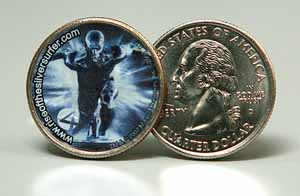
I received Standing Liberty Quarters (Fourth Edition) several weeks ago and have enjoyed reading through it. It’s amazing how much information one person can gather when they devote their life to a particular subject. J.H. Cline is not only a true expert on the Standing Liberty Quarter series, but he’s passionate about them and it shows.
Chapter 1 - Introduction
We start off with an account of how Cline’s lifelong love for the Standing Liberty Quarter began. It’s a quaint story about him as a young boy entering a coin shop for the first time. He left with a sparkling new 1917 Type I quarter, purchased for $7.50.
Chapter 2 - The Smithsonian Collection
He shares the experience he and Arnold Schwartz had to visit the Smithsonian to see the prized collection of Standing Liberty Quarters. He discusses the pieces and provides photos of them for your viewing pleasure.
Chapter 3 - Hermon MacNeil: The Designer
A fairly in-depth biographical sketch of Hermon MacNeil follows, including pictures of other sculptures and medals that MacNeil made, a list of his best-known works and MacNeil’s obituary.
Chapter 4 - Government Bureaucracy
Many of you are probably aware of the controversy that ensued when the new quarter design was released with an exposed breast. Cline clarifies that it was as originally designed, not, as a Congressional report claimed, a return to the original design of a covered breast. At the end of this section are dozens of letters to and from MacNeil regarding his work on the quarter design. It’s intriguing to read the details of their correspondence and I’m glad Cline chose to include the letters in their entirety instead of simply summarizing their content.
Chapter 5 - Miss Liberty Models
Here we find pictures of the two women who were both thought to be the models for the quarter’s design. Cline doesn’t make a declaration either way, but leaves it as an exercise for the reader to draw their own conclusion from the evidence given.
Chapter 6 - Error Coin Highlights
This section contains a gallery of the most impressive and amazing Standing Liberty Quarter errors and varieties I’ve ever seen. These are truly one of a kind pieces, and these pictures are probably the only ones you’ll have the chance to see.
Chapter 7 - The Connoisseur Section
Here he discusses the full head and non full head varieties, expounding on each and accompanied by several photographic examples of each. Each year is included, with a short blurb about the relative rarity, value and information about that particular date. He concludes with a section on the Eliasberg sale, with information about the various specimens it contained.
Chapter 8 - Year and Mintmark Analysis
In this section each year of the series is ranked by price and quantity, with the mintage and the estimated population by grade, along with an estimated percentage of full heads minted during that year. This chapter makes up the lion’s share of the book, and concludes with a detailed coverage of known varieties within the series.
Chapter 9 - Grading Criteria
As you could have guessed, this section describes how to determine the various grades for each of the three types in this series (Type I, II and III). Artistic renderings are included of what the coin might look like for each of the grades.
Chapter 10 - Value Analysis
He starts off with a pricing table for MS65 full head specimens which includes the price, mintage, price rank and quantity rank. This table is, as far as Cline knows, the only one of its kind. Next we find greysheet prices from 1979 to 2006, followed by red book prices from 1951 to 2007. He notes that coins with a full head often go for double the amount listed in the red book.
My conclusion
Anyone reading this book will feel that they are somewhat of an expert on this series after they’re done with it. So much information about the history of the designer, the design and the dates and varieties of this coin are included that you can’t help but learn more about the fascinating history of this short-lived series of quarters.
I heartily recommend anyone interested in undertaking a serious study or collection of Standing Liberty Quarters to pick up this book. At $14.93, it will probably be the lowest amount you’ll spend on the series.
Update (6/4/2007): I just got an e-mail from Jay Cline, the author, stating that a hardbound version will be available directly from him, with availability expected in a week or two.
J H Cline
PO Box 68
Palm Harbor, FL 34682-0068
Phone: (800) 749-2207
They’ll cost $34.95, plus $5.00 shipping/handling.
A limited edition of 100 (numbered) copies will also be available in a leather bound version at $100.00 each plus $5.00 shipping/ins/hand around the same time.
Thanks for the update Jay!

